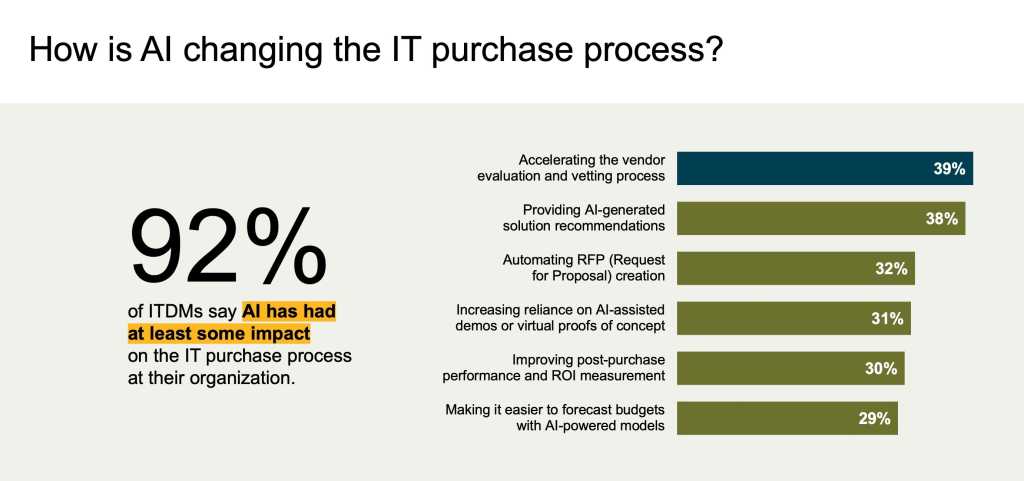IT leaders see AI as a vital tool for product research, vendor recommendations, and RFP analysis, as well as finding contract anomalies and opportunities for negotiation.

IT leaders are increasingly relying on AI to help with their purchasing decisions, with more than eight in 10 IT decision-makers saying they rely on the technology to make sense of the vendor and product landscape.
While only a small percentage of IT decision-makers say they rely heavily on AI for product research and recommendations, 81% use AI in some capacity in the IT purchasing process, according to a new report from CIO.com parent company Foundry.
About four in 10 of IT decision-makers surveyed use AI to assist with the vendor evaluation and vetting process, with a similar percentage using the technology for solution recommendations.
Meanwhile, about a third of respondents are using AI to automate the creation of RFPs. A similar percentage lean on AI to improve post-purchase performance and ROI measurement, while a third also rely on AI-assisted demos or virtual proofs of concept as part of their IT purchasing processes.
Do we need this product?
Morgan Watts, vice president of IT at 8×8, is among those IT leaders leveraging AI to streamline the IT purchasing process.
The unified communications vendor uses a generative AI model to help evaluate whether the company needs to purchase new IT products, Watts says. Employees run new tool requests through the company’s GPT model, which helps the purchasing team evaluate whether the new product is needed or if the company already has the requested functionality.

Foundry
“We have a GPT that we’ve created as an intake process that’s asking you to go through a set of questions of what you’re looking to try and solve, the values that you’re looking to achieve,” Watts says. “Do we already have a tool in place? It’s asking you to give some thought to why you want this particular tool.”
8×8’s internal GPT model also helps with product recommendations and assists with determining the ROI of new IT purchases, he adds. The AI also guides the company through a build-versus-buy discussion.
“The GPT really helps minimize a lot of the noise, and it shows the fact that at the back end, we’ve managed to budget,” Watts says. “If you have the budget right, it says, ‘I can go buy this product because there’s an enterprise architecture component, there’s data considerations, compliance,’ all these other areas that you may not be aware of in a request.”
Like most respondents in the survey, 8×8 leaves a human in the loop, however. While the AI makes recommendations about whether to buy new IT products, company leaders have the final say, Watts says.
Aaron Whittaker, vice president of demand generation at Thrive, says the digital marketing strategies provider uses AI at three points in the IT purchasing process: to create RFPs, to aid with testing services side by side as proofs of concept, and to evaluate vendors.
“AI promptly evaluates product documentation, reviews, and market reports, cutting the time it takes to evaluate vendors from weeks to days and unearthing compatibility problems that go unnoticed by human reviewers,” he says.
Like 8×8, Thrive uses a “trust but verify” approach that treats AI output as inputs for its decision-making processes, not final answers, Whittaker says. “AI is great for comparing technical specs, but it can’t help you much with assessing non-technical aspects such as quality of support, cultural fit, etc.”
Thrive plans to enhance its future AI models to predict defects in products, foresee deployment challenges, and monitor vendor performance, Whittaker says.
“To avoid over-trusting AI as if it knows better than people, we have put in place a formal review before some major decisions to recognize that maybe even some inefficiency might be okay along with an oversight,” he adds.
AI assistants for everyone
Finance-focused SaaS vendor BlackLine also began using AI in the IT purchase process recently, says Sumit Johar, CIO there. In June, BlackLine gave all employees access to a copilot-like AI tool, and the IT purchasing team has used AI to research products and vendors and to summarize information vendors submit in RFPs, he says.
“In the whole RFP process, you’ve got all these documents coming from these vendors, and you need to now go through all of them, and it can be a very time-consuming process,” he says. “AI is really good at that.”
BlackLine employees are also using AI to scan vendor contracts for unusual clauses, potential problem areas, and places the company might negotiate for additional savings, Johar says.
“When you are negotiating a contract, let’s say you received an order form, or you received a large legal contract, and it’s all unstructured data,” he says. “AI is really good at guiding you on what kind of commercial terms you should be careful with. It can look at your existing contracts and compare them with this new one and say, ‘This one has some anomalies.’”
The company’s use of AI is giving the IT team time to work on other priorities instead of spending extra time researching potential products, Johar says.
“If you look at how an IT organization works, we are buying software all the time, and sometimes it leaves you very little time to focus on real evaluation and piloting the software, because you just end up spending so much time on all these RFP processes, legal processes, and research,” he says. “If you can cut down time for all these ancillary activities, it gives you more time to do the actual evaluation of the technology.”










